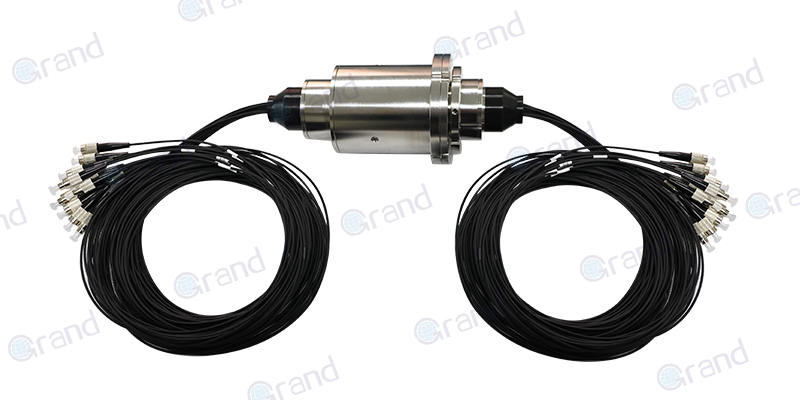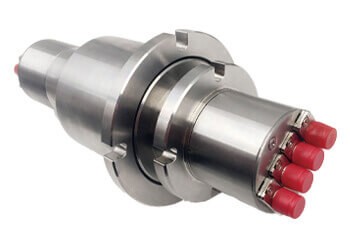For many of us, the term “slip ring” might be unfamiliar despite its widespread use in our day-to-day lives. In essence, slip rings are electromechanical devices that facilitate the transmission of electrical signals or power between a stationary system and a rotating system. This remarkable device serves as a pivotal connection, helping various pieces of equipment function seamlessly.
Taking this concept a step further, we encounter the relatively modern marvel – the brushless slip rings. As the name suggests, these are a type of slip rings that have done away with the “brushes” – a component traditionally used to transfer electric signals in conventional slip rings. Brushes, however, suffer from wear-and-tear and contact noise. Brushless slip rings being ‘contactless’ eliminate these concerns, leading to enhanced reliability, performance, and lifespan.
Brushless slip rings have reshaped our ability to handle complex rotation systems. With their unique ability to reduce friction significantly and minimize wear and tear, they bring unparalleled value to industries and applications where performance, low maintenance, and longevity are crucial. These could range from wind turbines, where the power generated by the rotating blades needs to be transferred to a stationary grid, to elaborate satellite systems ensuring communication from miles above.
Capable of handling a wide array of signals and offering a higher level of data integrity, brushless slip rings have proven to be an indispensable feature in the evolution of various industries. Offering a solution for a smoother and quieter operation, this innovation marks a significant leap in the evolution of electromechanical systems worldwide. As we delve deeper into this topic, it becomes evident how vital these seemingly small components are in our technologically advanced world.
The Design and Workflow of Brushless Slip Rings
As we delve further into the technological marvels offered by brushless slip rings, let’s take a closer look at their design and understand how these intricate pieces function.
Brushless slip rings can be visualized as a peculiar mix of structure and magic. Their primary structure is divided into two significant components – the stationary part and the rotating part. Wide-ranging applications might necessitate different designs, but this foundational structure remains a constant.
The Structure
The Rotating Part: Generally, this part incorporates a set of tracks. These concentric tracks are like roadways that guide the electrical signals ensuring the safe transmission of power or data.
The Stationary Part: Contrasting its name, this part hosts a bevy of activities. Its function is to house sensors or antennas that indulge in a ‘contactless dance’ with the rotating tracks. They pick up the signals as they dance past them and transfer them to relevant channels.
Innovatively designed, brushless slip rings result in minimal friction and wear due to the lack of direct contact between the crucial components. This non-contact approach significantly increases the lifespan of the device and reduces the requirement for frequent maintenance.
The Workflow
Now, let’s proceed to the heart of the brushless slip rings – its operation. When a brushless slip ring is put to work, a sophisticated and smooth transmission of power and data takes place. Using contactless technology like capacitive, inductive, or radio frequency, the electrical signals are transferred from the rotating tracks to the stationary antennas or sensors. This absence of contact eliminates physical wear and offers significant benefits in data quality due to reduced noise and interference.
Each component within this system plays a distinct and indispensable role. The rotating tracks hold and transport signals, while the stationary sensors interpret these signals. Together, they form a symphony of components working in perfect harmony, ensuring reliable and durable performance in demanding applications.
Understanding the structure and workflow of brushless slip rings not only impresses upon us the remarkable engineering but also underscores the importance of each component. This explains why these subtle heroes are the lifeblood of various applications that are fundamental to modern life.

Types of Brushless Slip Rings
In the world of brushless slip rings, one size doesn’t fit all. Various technological applications have different needs, and different types of brushless slip rings have been optimized to cater to these diverse requirements. Let’s explore some of these variants:
Capacitive Slip Rings
Capacitive slip rings, as the name suggests, leverage capacitance – the ability of a system to store an electric charge. They transmit signals across the rotating and stationary assembly using electric fields. In essence, the moving part creates variations in capacitance, which are captured by the stationary part and decoded into electrical signals.
These variants offer several benefits, such as zero physical contact and therefore, zero friction. They are lightweight and boast a compact design, making them ideal for applications where space and weight constraints are a significant consideration.
Inductive Slip Rings
Inductive slip rings utilize magnetic fields to transmit signals between the rotating and stationary assembly. The rotating part houses a primary coil that generates a magnetic field, which then induces a voltage in the secondary coil in the stationary part. This voltage is then deciphered as the electrical signal.
These slip rings provide reliable and contact-free performance, making them perfect for applications in need of high-speed data transmissions or those that demand impeccable reliability.
Radio Frequency (RF) Slip Rings
RF slip rings stand as the tribune of wireless technology in the world of slip rings. They use wireless communication technologies to transmit data and power among the rotating and stationary parts. They work by converting and modulating data signals into radio frequency signals to be sent across the rotating contact.
The strength of RF slip rings lies in their capability to transmit without loss and handle high data transfer rates, making them ideal for communication-intensive applications that can’t afford signal losses.

Brushless Slip Ring Specification
When specifying a brushless slip ring, it’s important to outline the key technical and operational parameters to ensure it meets the requirements of your application. Below is a detailed list of typical specifications to consider:
Electrical Specifications
- Voltage Rating:
- Operating Voltage: Specify the maximum operating voltage (AC or DC).
- Insulation Voltage: Determine the insulation resistance and dielectric strength.
- Current Rating:
- Continuous Current: Maximum continuous current each channel can handle.
- Peak Current: Maximum peak current for short durations.
- Number of Circuits:
- Power Circuits: Number of circuits dedicated to power transmission.
- Signal Circuits: Number of circuits dedicated to signal transmission.
- Signal Type:
- Specify the types of signals (analog, digital, Ethernet, USB, etc.).
- Frequency Range:
- Signal Frequency: Maximum frequency for signal transmission.
Mechanical Specifications
- Dimensions:
- Outer Diameter: Maximum allowable outer diameter.
- Inner Diameter (if through-bore): Minimum required inner diameter.
- Length: Maximum allowable length.
- Rotational Speed:
- Maximum Rotational Speed: Specify the maximum operating RPM.
- Contact Material:
- Specify the contact materials (e.g., gold, silver) for longevity and reliability.
- Mounting Style:
- Flange Mount: Type and size of the flange.
- Through-Bore: Inner diameter and length.
- Other Mounting Options: Any specific mounting requirements.
Environmental Specifications
- Operating Temperature Range:
- Minimum and Maximum Operating Temperature.
- Ingress Protection (IP) Rating:
- Specify the required IP rating for dust and moisture protection.
- Vibration and Shock Resistance:
- Vibration: Maximum allowable vibration levels.
- Shock: Maximum allowable shock levels.
- Humidity:
- Operating Humidity Range: Maximum allowable humidity levels.
Performance Specifications
- Electrical Noise:
- Maximum allowable electrical noise (mV).
- Resistance:
- Contact Resistance: Maximum contact resistance per channel.
- Insulation Resistance: Minimum insulation resistance between circuits.
- Durability:
- Life Cycle: Expected number of operational cycles.
Additional Features
- Hybrid Capability:
- Ability to transmit both power and signals.
- Compatibility with different types of signals.
- Special Requirements:
- Fiber Optic Channels: If optical signal transmission is needed.
- High-Speed Data Transmission: Capabilities for high data rate applications.
- Customization:
- Any specific customization requirements for the slip ring.
Choosing the Right Brushless Slip Ring
Determining the type of brushless slip ring that suits a specific application depends on several criteria. This could include – signal types and data rates, environmental constraints, physical dimensions, power requirements, frequency of operation, desired longevity, and sometimes, even budget.
For instance, if you’re working on a project where space is at a premium and low-weight components are crucial, a capacitive slip ring could be an excellent choice. On the other hand, for an application requiring high-speed and reliable data transmissions, an inductive slip ring would fit the bill.
Unraveling the different types of brushless slip rings gives us a glimpse of the tailored solutions available in the market. Each comes with its unique strengths designed to perfectly match a spectrum of needs across various industries.
Selecting the appropriate brushless slip ring for your application involves considering several key factors to ensure optimal performance and longevity. Here are some guidelines to help you choose the right brushless slip ring:
1. Application Requirements
- Electrical Specifications: Determine the voltage, current, and frequency requirements for your application. Brushless slip rings can handle a range of electrical specifications, so it’s essential to match these to your needs.
- Signal Types: Identify the types of signals you need to transmit (e.g., power, analog, digital, Ethernet, etc.). Some slip rings are designed to handle specific signal types better than others.
2. Mechanical Considerations
- Size and Weight: Consider the physical space available in your application and the weight constraints. Brushless slip rings come in various sizes and configurations.
- Rotational Speed: Determine the maximum rotational speed required. Brushless slip rings are designed to operate at different speeds, and selecting one that matches your needs will ensure better performance and durability.
- Mounting Options: Ensure that the slip ring can be easily integrated into your system. Check for compatibility with your mounting requirements (e.g., flange mount, through-bore, etc.).
3. Environmental Conditions
- Temperature Range: Ensure that the slip ring can operate within the temperature range of your application. Brushless slip rings are available with different temperature ratings.
- Ingress Protection: Determine the level of protection required against dust, moisture, and other environmental factors. Look for slip rings with appropriate IP ratings.
- Vibration and Shock: If your application involves high levels of vibration or shock, choose a slip ring that can withstand these conditions.
4. Longevity and Maintenance
- Durability: Brushless slip rings are known for their long service life. However, ensure that the one you choose has a proven track record of reliability.
- Maintenance Requirements: Some slip rings require periodic maintenance. Choose one with minimal maintenance requirements if continuous operation is critical.
5. Customization and Special Features
- Customization Options: Some manufacturers offer custom slip rings tailored to specific applications. If you have unique requirements, consider discussing customization options.
- Special Features: Look for additional features that may benefit your application, such as low noise, high data transfer rates, or the ability to transmit mixed signals (power and data).
6. Cost and Support
- Budget: Consider your budget and the cost of the slip ring. While it’s important to find a cost-effective solution, ensure that quality and performance are not compromised.
- Technical Support: Choose a supplier that offers good technical support and after-sales service. This can be crucial for troubleshooting and maintaining the slip ring.
By carefully considering these factors, you can select the right brushless slip ring that meets your specific application requirements and ensures reliable and efficient operation.
Advantages of Brushless Slip Rings over Traditional Slip Rings
The evolution from traditional slip rings to brushless slip rings represents a significant progression in the pursuit of better performance and longevity. Where traditional slip rings served adequately for many years, the innovation of brushless slip rings has ushered in an era of enhanced capabilities across numerous applications. Let’s see how these two compare and what makes the brushless variant an increasingly preferred choice.
More Reliable Data Transmissions
Data integrity remains one of the most critical aspects of several applications. Traditional slip rings, due to their mechanical contact, can succumb to disturbances that lead to signal noise and loss. In contrast, brushless slip rings, through their non-contact technologies (capacitive, inductive, or radio frequency), ensure more reliable and cleaner data transmissions. This reliability can significantly improve performance in applications like high-speed data transmission systems, communication devices, and sophisticated robotics.
Less Friction and Minimized Wear and Tear
Traditional slip rings use brushes that physically contact the rotating surface, leading to friction. Over time, this friction results in wear and tear, reducing the lifespan of the device and leading to frequent maintenance requirements. Here, brushless slip rings clearly leverage an advantage. The absence of contact between rotating and stationary parts minimizes friction almost entirely – mitigating wear and significantly extending the functionality and longevity of the device. This is a boon for applications where extended maintenance periods are costly or challenging, such as wind turbine systems or satellite antennas.
Lower Noise and Interference Levels
The presence of brushes in traditional slip rings not only makes these devices prone to mechanical wear and tear but also contributes to electrical and acoustic noise. This noise can interfere with the quality of signal transmission, making them less suitable for sensitive applications. Brushless slip rings, on the other hand, since they involve no mechanical contact, produce virtually no noise – electronic or acoustic. This feature enhances their suitability in noise-sensitive environments like broadcasting or medical scanning equipment.
Longer Service Life
As a culmination of the above advantages, brushless slip rings typically enjoy a longer service life. The reduced friction, absence of wear and tear, and reliable functionality underpin a robust device that stands the test of time. They offer phenomenal durability, reducing the total cost of ownership by cutting down on maintenance expenses and replacements.
In a nutshell, while traditional slip rings continue to have their place in specific applications, brushless slip rings offer a plethora of advantages that make them a smarter choice for modern, high-performance, demanding applications. This comparison underscores the innovation that brushless slip ring technology represents and the value it brings to various industries.
Applications of Brushless Slip Rings
Brushless slip rings, owing to their technological advancements and myriad advantages, extend their influence across several industries. Their ability to transmit reliable data while minimizing friction, noise, and potential points of failure makes them a key player in multiple applications. Let’s have a look at some domains that take advantage of these ingenious devices.
Renewable Energy
One of the major sectors that rely on brushless slip rings is the renewable energy industry, especially wind power. Wind turbines often need to rotate freely to face winds from different directions, yet they still need stable power and data transmission. Brushless slip rings come in handy here by facilitating communication between stationary and rotating parts, hence ensuring the reliable functioning of the wind turbine.

Medical Technology
In the field of medical technology, brushless slip rings are commonly found in devices like CT scanners. These machines require the scanner to rotate around the patient continuously, and at the same time, they need to transmit sensitive data with high integrity. The frictionless operation and reliable data transmission of brushless slip rings make them an ideal solution for such precise applications.

Defense & Aerospace
In aerospace and defense sectors, the role of brushless slip rings is quite predominant. Satellites, for instance, incorporate brushless slip rings to ensure that data and signals are transferred accurately between the rotating and stationary parts without any disruption. These slip rings are designed to withstand harsh cosmic conditions and prolonged operational periods.

Industrial Automation
Industrial automation thrives on components working seamlessly together. High-performing robots and automated systems need precise and efficient data flow between stationary controls and rotating units. Brushless slip rings cater to this need by providing reliable, uninterrupted communication while ensuring a longer lifespan with less maintenance.

Broadcasting
Brushless slip rings enable free movement in broadcasting equipment, notably in devices like pan-tilt-zoom (PTZ) cameras. They ensure the transmission of high-quality audio and video signals while the camera is rotating, enhancing signal quality and eliminating mechanical wear.
These real-world examples highlight the expansive footprint brushless slip rings have on multiple industries. Their efficient and reliable operation combined with low maintenance, make them a preferred choice for a wide array of modern applications. From keeping the lights on using renewable energy to enabling sophisticated healthcare diagnoses, broadcast video streaming, and powering our exploration of space – brushless slip rings play a vital role across industries.
Brushless Slip Ring Technology
Brushless slip ring technology is an advanced solution designed to transmit electrical signals and power between stationary and rotating parts without the use of traditional mechanical contacts. This technology offers numerous benefits over traditional slip rings, including higher reliability, longer lifespan, and maintenance-free operation. Here are the key aspects and advantages of brushless slip ring technology:
Key Aspects of Brushless Slip Ring Technology
- Contactless Transmission:
- Utilizes capacitive or inductive coupling to transmit signals and power.
- Eliminates physical contact between rotating and stationary components.
- Capacitive Coupling:
- Uses capacitors formed between rotating and stationary electrodes.
- Suitable for high-frequency signal transmission with minimal loss.
- Inductive Coupling:
- Employs magnetic fields generated by coils in the rotating and stationary parts.
- Ideal for power transmission and low-frequency signals.
- High-Speed Operation:
- Capable of operating at high rotational speeds without wear and tear.
- Suitable for applications requiring high RPM.
- Maintenance-Free:
- No physical contact means no wear on components.
- Significantly reduces maintenance requirements and downtime.
- High Signal Integrity:
- Minimizes signal loss and interference.
- Ensures high-quality signal transmission, crucial for data and communication applications.
Advantages of Brushless Slip Ring Technology
- Increased Reliability:
- Lack of mechanical contacts reduces the risk of failure.
- Suitable for critical applications requiring continuous operation.
- Longer Lifespan:
- Durable design leads to a much longer operational life compared to traditional slip rings.
- Can exceed millions of rotations without degradation in performance.
- Low Electrical Noise:
- Smooth and consistent signal transmission with minimal electrical noise.
- Essential for precision applications like medical equipment and instrumentation.
- Versatility:
- Capable of handling various signal types, including analog, digital, and high-frequency data.
- Can also transmit power and mixed signals simultaneously.
- Compact Design:
- Smaller form factor compared to traditional slip rings.
- Easier to integrate into space-constrained applications.
- Environmental Resistance:
- Better suited for harsh environments with high vibration, shock, dust, and moisture.
- Enhanced protection through robust design and materials.
Brushless slip ring technology represents a significant advancement over traditional slip rings, offering numerous benefits in terms of reliability, lifespan, and performance. By eliminating mechanical contacts and utilizing contactless transmission methods, brushless slip rings provide a robust and maintenance-free solution for a wide range of applications. Whether in medical equipment, aerospace, industrial automation, or renewable energy, brushless slip rings deliver consistent and high-quality performance, making them an ideal choice for modern, demanding applications.
Factors to Consider When Choosing Brushless Slip Rings
Selecting the right brushless slip ring for a particular application can significantly impact the performance and longevity of both the slip ring and the system it supports. Each application presents a unique set of requirements, and it is crucial to evaluate various factors to ensure compatibility. Here is a guide to help you navigate the process and make informed decisions when choosing brushless slip rings:
Load Capacity
Different brushless slip rings have varying capabilities to transmit power and data loads. Assess the requirements of your application in terms of current, voltage, and bandwidth, and ensure that the chosen brushless slip ring meets or even exceeds these parameters. Investigate if there is a chance of a future increase in load, and choose a slip ring that can accommodate these potential growths.
Signal Type
Consider the type of signals the slip ring will need to transmit. This can include data, power, or a combination of the two. Check if your system uses digital or analog signals, and verify that the chosen slip ring can handle that signal type efficiently at the required data rates. For high-speed data transmission or communication-intensive applications, ensure that the slip ring type is tailored to cater to these demands.
Size and Physical Dimensions
The brushless slip ring you select should fit seamlessly into the allocated space of your application. Consider the dimensions: the outer diameter, inner diameter, thickness, and length. Also, ponder on factors like weight constraints, which become crucial in aerospace, robotics, or other applications where reducing device weight is a priority.
Operating Environment
Your chosen brushless slip ring should be robust enough to withstand the environmental conditions it will be exposed to, such as extreme temperature fluctuations, humidity, or even corrosive substances. Ensure that the materials and design of the slip ring cater to these specifications. If used in noise-sensitive environments, pick a slip ring that minimizes electronic and acoustic noise interference.
Cost and Quality
While the overall budget may play a significant role in the selection process, avoid compromising on quality for cost savings. A lower-priced brushless slip ring may have a shorter lifespan, require more frequent maintenance, or offer suboptimal performance. Weigh the costs against the potential benefits or drawbacks before making an informed decision.
Manufacturer and Technical Support
It is essential to source your brushless slip ring from a reputed manufacturer with a proven track record in quality and reliability. In addition to product quality, consider the level of technical support provided by the manufacturer in terms of guiding you through installation, troubleshooting, or offering advice on maintenance.
By evaluating these factors, you can ensure that the chosen brushless slip ring appropriately fits your application’s needs, performance requirements, and budget constraints. This thorough approach will substantially enhance your system’s overall integrity, longevity, and efficacy.
The Future of Brushless Slip Rings
The advent of the brushless slip rings signifies a considerable shift in how we perceive and utilize slip ring technology. It appears to have only scratched the surface of its potential and, looking forward, we can anticipate the exploration of new features and functionalities, evolution in design, and more advanced application scopes for these devices. Here’s what might lie in store for the future of brushless slip rings:
Miniaturization and Increased Load Capacity
As industries trend towards compact and efficient devices, we may anticipate a future where brushless slip rings are even smaller yet more powerful. Advances in materials and design engineering can pave the way for compact slip rings capable of transmitting higher power and data loads without compromising on their space-saving features. This will widen their applicability in small-scale robotics, drones, and other compact devices.
Improved Signal Integrity and Bandwidth
Continued research and development efforts will likely focus on further improving the already impressive data transmission capacities of brushless slip rings. As the demand for real-time, high-speed data transmission increases across industries, we can expect future brushless slip rings to provide even better signal integrity and expanded bandwidth options.
Enhanced Durability and Environment Resilience
While brushless slip rings already boast a long service life due to their non-contact nature, future models might see an even longer lifespan. Advances in materials science could lead to slip rings that are more resistant to wear and tear and harsh environmental conditions. Future slip rings will likely be more resilient, withstanding extreme temperatures, corrosive substances, or even cosmic radiation – making them ideal for space and undersea applications.
Integration with Emerging Technologies
The future of brushless slip rings could be shaped by their integration with emerging technologies. Potential developments could include advancements in wireless power transmission, AI incorporation for predictive maintenance, or IoT integration for better remote monitoring and control. These enhancements would not only increase the efficiency and reliability of brushless slip rings but also make them more manageable and user-friendly.
Green Technology
As sustainability becomes imperative across industries, the development of eco-friendlier brushless slip rings is a realistic expectation. This can manifest as energy-efficient designs, the use of recyclable materials, or processes that reduce environmental impact during manufacturing, usage, and disposal stages.
The landscape of brushless slip rings is expected to keep evolving, responding to the diverse needs of different industries. As we move into the future, these devices are anticipated to play an increasingly seminal role, thanks to their prowess to continually adapt, perform, and exceed expectations.
Conclusion
Brushless slip rings offer a significant leap forward in terms of reliability, signal quality, and overall performance compared to traditional slip rings. By understanding their design, advantages, applications, and future prospects, users can make informed decisions when choosing the optimal slip ring for their specific needs.
FAQs about Brushless Slip Rings
Brushless slip rings, despite their widespread applications, are often subject to misconceptions or generate queries simply due to their unique, cutting-edge nature. Here, we address some of the most common questions and concerns:
Q1: What is the difference between a brushless slip ring and a traditional slip ring?
A: A brushless slip ring, unlike traditional slip rings that rely on mechanical brushes to maintain contact between the rotating and stationary parts, uses non-contact technology, usually through electromagnetic or capacitive coupling, for power and data transmission. This reduces friction and wear, resulting in quieter operation, longer service life, and minimal maintenance.
Q2: Are brushless slip rings suitable for high-speed applications?
A: Yes, brushless slip rings are ideal for high-speed applications due to their frictionless operation, something that is not the case with traditional slip rings. Since there is no physical contact between the components, brushless slip rings can accommodate higher rotational speeds while ensuring efficient and reliable data transmission.
Q3: How do brushless slip rings prevent signal noise and interference?
A: Brushless slip rings minimize noise and interference by eliminating friction, which is a significant source of signal noise in traditional slip rings. Additionally, they are designed with shielding and grounding techniques that help reduce electromagnetic interference (EMI), thus ensuring better signal integrity and quality.
Q4: Can brushless slip rings operate in harsh environments?
A: Yes, brushless slip rings are designed to withstand various environmental challenges, making them suitable for harsh operating conditions. Depending on the specific requirements of your application, they can be engineered to cope with extreme temperatures, exposure to corrosive substances, and high levels of moisture or dust. However, it is essential to select a brushless slip ring designed for the environment it will be used.
Q5: Are brushless slip rings expensive compared to traditional slip rings?
A: While brushless slip rings might have a higher initial cost compared to traditional slip rings, they usually offer long-term cost savings due to their low maintenance requirements, reduced downtime, and increased service life. Hence, when considering the overall cost of ownership, brushless slip rings often prove to be a more cost-effective choice.
Q6: Can I find a brushless slip ring tailored to my specific application?
A: Brushless slip rings can be customized to meet the unique requirements of different applications. Leading manufacturers offer a range of customizable options, such as altering the size, load capacity, signal types, and other project-specific parameters. It is recommended to partner with a reputable manufacturer who can provide reliable guidance and technical support for your exact needs.
See What We Can Do

